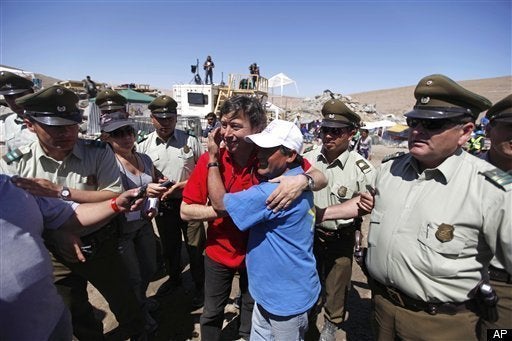
As Chile remains the myth-laden crock pot into which America's most dedicated free-market fetishists have long steeped their Chicago-school goulash, it was only a matter of time before someone from the Wall Street Journal came along to revise "Footprints" in the matter of the rescued Chilean miners: "My precious child, when you saw yourself lifted out of the darkest hole of your life, 'twas Milton Friedman who carried you."
Right on time, here's Daniel Henninger:
It needs to be said. The rescue of the Chilean miners is a smashing victory for free-market capitalism.
Amid the boundless human joy of the miners' liberation, it may seem churlish to make such a claim. It is churlish. These are churlish times, and the stakes are high.
Actually, it's not nearly as churlish as Henninger's colleague, Bret Stephens' after-action report on the Chilean earthquake, in which he said that Friedman's "spirit was surely hovering protectively over Chile in the early morning hours" of the Saturday after the earthquake. But it is equally stupid. In Stephens' capitalist fantasia, Friedman's invisible hand authored the building codes that preserved human life in the quake. In reality, those codes were put in place by Salvador Allende, and weren't revised until 1993, three years after the reign of Friedman's bag-man, Augusto Pinochet.
Today, Henninger says capitalism was the hero, because it made some things (which were subsequently donated, but never mind):
Center Rock Inc. is a private company in Berlin, Pa. It has 74 employees. The drill's rig came from Schramm Inc. in West Chester, Pa. Seeing the disaster, Center Rock's president, Brandon Fisher, called the Chileans to offer his drill. Chile accepted. The miners are alive.
Longer answer: The Center Rock drill, heretofore not featured on websites like Engadget or Gizmodo, is in fact a piece of tough technology developed by a small company in it for the money, for profit. That's why they innovated down-the-hole hammer drilling. If they make money, they can do more innovation.
This profit = innovation dynamic was everywhere at that Chilean mine. The high-strength cable winding around the big wheel atop that simple rig is from Germany. Japan supplied the super-flexible, fiber-optic communications cable that linked the miners to the world above.
Henninger could have gone much further! Consider the fact that Oakley donated a pair of $450 sunglasses to each miner, all in the name of protecting the miners' eyes as they adjusted from being out of a dark hole. Of course, it's not like Oakley, realizing that numerous teevee cameras would be pointed at the miners as they emerged, didn't have an ulterior motive:
In worldwide television impact alone, Oakley garnered $41 million in equivalent advertising time, according to research done for CNBC from Front Row Analytics, a sponsorship evaluation firm.
See, because "Nameless Miner #17 for Schram Inc." doesn't have the same zing, Henninger takes up their cause, so that they can play this game like Oakley.
Meanwhile, I can't deny that Henninger is right that the "profit = innovation" dynamic "was everywhere at that Chilean mine. To wit:
The problems is mainly down to a lack of unions, which he says are a necessary precursor for safety because "it means employees can have power at the workplace rather than just power on paper".
"It is also related to the weakness of the labour laws and enforcement in these countries," he says.
He cites Chile as an example, which he says has more than 900 mines, yet only 18 safety inspectors to regulate conditions.
Over at the Awl, Choire Sicha offers a further corrective, emphasis in the original:
The miners were also employees of a "free-market capitalist" corporation which is undergoing an (state-run!) audit and is likely going into bankruptcy. The miners were rescued by a government-sponsored intervention, supervised by Codelco, the state's copper company, and by gifts from foreign governments. What's more, the rescue seems to have convinced Chile that Codelco should remain state-run and not be privatized.
Likewise, the expertise of NASA -- the American government agency? -- is credited with keeping the miners healthy.
The free-market capitalist company who ran the mine, Empresa Minera San Esteban, was an out-of-control, anti-union, government-regulation defying safety nightmare who allowed its workers to become trapped as par for the course of its worker mistreatment.
Anyway, I guess it was nice of "capitalism" to save those miners, since it was basically the reason they were down that hole in the first place!
[Would you like to follow me on Twitter? Because why not? Also, please send tips to tv@huffingtonpost.com -- learn more about our media monitoring project here.]
